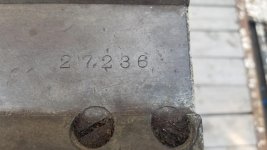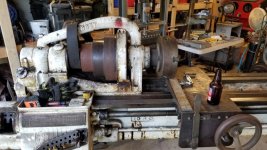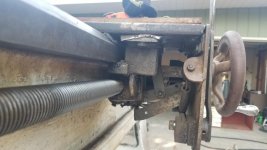jimsnell:
Hendey lathe No.27236, a 16 x 8 Cone Head model, was completed during the second week of September 1928. It was shipped with a Compound
Rest, a Taper Attachment and a set of No.6 Collets. The original owner was the Hallidie Machinery Company, Seattle, Washington. There
are no longer any Patterns, Castings or Repair Parts left in inventory for this lathe, but all of the original drawings are still in the
files, so parts can be made as required.
There are several issues to consider here, firstly the matter of Feed direction. As Johnoder has pointed out , the Feed Reversing Shaft is still installed and provided that the Bell Cranks have not been damaged, you should be able to operate the Dog Clutch without too
much trouble. Because the goal is to get the lathe operational with the least expense and time delay, use a set of vice grip pliers as
a make shift handle. Wrap a piece of shim stock around the shaft to prevent marring the surface. Test the shaft in all three positions
and see if you can get the "carriage" to travel in the proper direction. Because the Apron is missing, you will have to engage the Half
Nuts anytime you want longitudinal travel. For cross feed, you could mount a Top Slide off another lathe on the "carriage" and adjust it
for center height. Except for screw cutting, I would recommend hand feeding for all other operations.
The broken piece on the Intermediate Gear Housing shouldn't prevent it from operating properly. I would suggest that considering the
basic condition of the Gear boxes, "carriage" and "apron" that the Intermediate Gear should be disengaged, except for screw cutting.
As you learn more about the operating conditions of this lathe, you can keep it engaged more often. Considering the many unknown factors
regarding this lathe, it is best to make haste slowly.
One more note about using parts from other lathes of the same size. You must take into account when the donor lathe was built, because
the parts may not interchange. Hendey made small changes to the Beds, Carriages, Aprons, Headstocks and Tailstocks over the years. While
some of these changes were very small, they will prevent the parts from being used on lathes of a different period without a great deal
of hand fitting. If you do acquire parts from a different lathe, please post the Serial Number from the donor lathe, if possible, and I
will check the drawings to make sure they are suitable for your lathe.
Hendeyman















